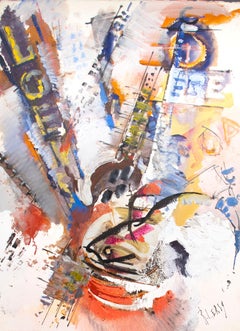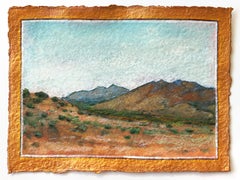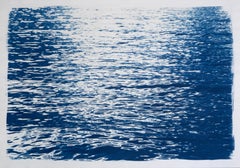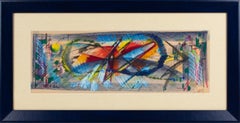Roger Lersy Landscape Drawings and Watercolors
French, 1920-2004
Roger Lersy is a French painter, lithographer, and composer, born in Paris on April 2, 1920, and died in Orsay on June 22, 2004. He belongs to the School of Paris and the Young Painting movement.
Roger Lersy was born in the 18th arrondissement of Paris on April 2, 1920. Studying the piano from his earliest childhood, likewise "beginning to draw on his father's lap", Roger Lersy, son of a decorator, enters after his schooling and for three years at the École supérieure des arts appliqués Duperré in Paris. Having then begun to paint, living at 19, rue du Faubourg-Saint-Antoine, he then worked as a decorator, however between 1950 and 1954 pursuing higher musical studies with Noël Gallon, continuing after 1954 – the year when the galleries, both in Paris and abroad, begin to exhibit it regularly —, to practice painting (canvases, watercolors, tapestry cartoons) and music together.
From 1961 to 1968, Lersy lived in the United States. From 1970 he went on to personal exhibitions, among others in Paris, London, Geneva, Houston, Los Angeles, and New York. Roger Lersy was initiated into the first degree of Freemasonry in the Ancient Scottish Rite and Accepted in 1979, in the Grand Val Lodge, meeting at the time in Perreux-Sur-Marne, Orient de Sucy-en-Brie (later Orient of Créteil, Val-de-Marne) of the Grand Lodge of France.
Leading two careers at the same time, Roger Lersy has left paintings that are seen as all "rhythms and quivers". In his paintings, the motif develops along a melancholy line with well-concerted chords, pauses, and cadences. One could define Lersy as a "baroque expressionist". For Bernard Dorival, Roger Lersy is, along with Gabriel Dauchot, Jean Commère, and Raymond Guerrier, among "the most noted champions of this expressionism which follows on from the misery of Bernard Buffet”.
Lesser-known parts of Roger Lersy, he was also interested in mosaics, sculpture, stained glass and undertook creations for public and private buildings.
Roger Lersy does not belong to "Musicalism" in painting in the sense that the word "Musicalism" historically refers to a group of painters formed around Henri Valensi from 1932. But if we admit with Raymond Bayer in his review of aesthetics that "Musicalism is not a school but a doctrine of art, a body of knowledge constituting a system", the term can then, by extension, be compared to Roger Lersy in whom music and aesthetic effects (his arabesques and hatched lines of incredible virtuosity for one, his backgrounds of streaks always of spectacular virtuosity for the other), remain in permanent contact.
Roger Lersy died in Orsay (Essonne) on June 22, 2004.to
1
Overall Width
to
Overall Height
to
1
1
1
1
1
1
1
1
9
143
125
66
60
1
Artist: Roger Lersy
New York
By Roger Lersy
Located in Chicago, IL
This watercolor of New York City bursting with energy in the 1960s is typical of Lersy's colorful and exuberant style. His work combines mid-century Modern abstraction with subjects...
Category
Mid-20th Century Modern Roger Lersy Landscape Drawings and Watercolors
Materials
Mixed Media, Watercolor
Related Items
Amarillo By Morning - Desert Landscape Nature Painting on Handmade Paper
Located in Los Angeles, CA
Michaela Jean is an accomplished painter, devoted gardener, and mother from Southern California (USA). Her lifelong passion for art and nature began in childhood, inspired by her gra...
Category
2010s Impressionist Roger Lersy Landscape Drawings and Watercolors
Materials
Ink, Acrylic, Watercolor, Color Pencil, Mixed Media, Handmade Paper
Blue Abstract Ripples Under Moonlight, Contemporary Cyanotype, Water Reflections
By Kind of Cyan
Located in Barcelona, ES
This is an exclusive handprinted limited edition cyanotype.
"Abstract Ripples Under Moonlight" is a handmade cyanotype print portraying the subtle movements and abstract ripples of t...
Category
2010s Abstract Roger Lersy Landscape Drawings and Watercolors
Materials
Emulsion, Mixed Media, Watercolor, Photographic Paper, Monoprint, Monotype
Flower 11:35am, Flower, Floral, Watercolor, Work on Paper, Pink, Trees
By Cynthia MacCollum
Located in Riverdale, NY
Flower 11:35 am is a watercolor work on paper by Cynthia MacCollum. This original artwork is 12x9 on archival paper. It is currently unframed. It was part of a series based on ima...
Category
2010s Contemporary Roger Lersy Landscape Drawings and Watercolors
Materials
Mixed Media, Watercolor, Archival Paper, Monoprint
Country Landscape - Late 19th Century Countryside Painting by Lewis George Fry
By Lewis George Fry
Located in Watford, Hertfordshire
Lewis George Fry (1860 - 1933)
Lewis George Fry was a British painter who was born in 1860 in Clifton, Bristol UK.
This piece was created with mixed media and is in a gilt frame un...
Category
Late 19th Century Post-Impressionist Roger Lersy Landscape Drawings and Watercolors
Materials
Mixed Media, Watercolor
$767
H 12.8 in W 17.05 in D 0.95 in
Greek Islands - Mixed Media by Robert Sauterne - 20th Century
Located in Roma, IT
Greek Islands is a drawing in mixed media (pencil, ink and watercolor) on cardboard realized by Robert Sauterne.
The State of preservation is good, with a small stain along the left...
Category
20th Century Modern Roger Lersy Landscape Drawings and Watercolors
Materials
Mixed Media, Ink, Watercolor, Pencil
$599
H 15.36 in W 21.66 in D 0.08 in
Where a Mermaid Goes... - Vibrant Seascape Still Life Painting on Handmade Paper
Located in Los Angeles, CA
Michaela Jean is an accomplished painter, devoted gardener, and mother from Southern California (USA). Her lifelong passion for art and nature began in childhood, inspired by her gra...
Category
2010s Impressionist Roger Lersy Landscape Drawings and Watercolors
Materials
Ink, Mixed Media, Acrylic, Watercolor, Handmade Paper, Color Pencil
Flower 8:54am, Landscape, Watercolor, Work on Paper, leaves, flowers
By Cynthia MacCollum
Located in Riverdale, NY
Flower 8:54 am is a watercolor work on paper by Cynthia MacCollum. This original artwork is 12x9 on archival paper. It is currently unframed. It was part of a series based on imag...
Category
2010s Contemporary Roger Lersy Landscape Drawings and Watercolors
Materials
Mixed Media, Watercolor, Archival Paper, Monoprint
Flower Moon 1:40pm, Botanical, Floral, Watercolor, Work on Paper, Flowers
By Cynthia MacCollum
Located in Riverdale, NY
Flower Moon 1:40pm is a watercolor work on paper by Cynthia MacCollum. This original artwork is 12x9 on archival paper. It is currently framed to 14 x 11. It was part of a 2020 series based on images captured during the 13 Moons of the year. It is a one of a kind botanical artwork...
Category
2010s Contemporary Roger Lersy Landscape Drawings and Watercolors
Materials
Mixed Media, Watercolor, Archival Paper, Monoprint
Dancing for Rain
Located in San Francisco, CA
This artwork titled "Dancing for Rain" c.1990 is a watercolor, with gold addition and with the decorated hand carved and painted frame by southwestern artist Fran Larsen, b.1937. It ...
Category
Late 20th Century Post-Impressionist Roger Lersy Landscape Drawings and Watercolors
Materials
Mixed Media, Watercolor
Magical Life Below - Ocean Landscape Fish Still Life Painting on Handmade Paper
Located in Los Angeles, CA
Michaela Jean is an accomplished painter, devoted gardener, and mother from Southern California (USA). Her lifelong passion for art and nature began in childhood, inspired by her gra...
Category
2010s Impressionist Roger Lersy Landscape Drawings and Watercolors
Materials
Ink, Mixed Media, Acrylic, Watercolor, Handmade Paper, Color Pencil
Advertising Graphic project for FIAT by Marco Silombria. Circa 1980
Located in Firenze, IT
Car rally. Fiat factory team.
Marco Silombria (Savona, 1035- Turin, 2014)
Mixed media: drawing, watercolor, pencils on paper, applied to hard support
Around 1980.
Marco Silombria...
Category
1970s Pop Art Roger Lersy Landscape Drawings and Watercolors
Materials
Plastic, Paper, Mixed Media, Watercolor, Illustration Board, Pencil
$694
H 26.38 in W 30.32 in
STREET ACAPULCO
By Joseph Pennell
Located in Santa Monica, CA
JOSEPH PENNELL (1857 - 1926)
STREET ACAPULCO 1901-08. Color pastel and gouache drawing on blue paper. Signed and titled in pencil in his early signature. Image, 10 x 14 inches to j...
Category
Early 1900s American Impressionist Roger Lersy Landscape Drawings and Watercolors
Materials
Pastel, Mixed Media, Gouache
Previously Available Items
Abstract Cubist Watercolor Painting by Roger Lersy
By Roger Lersy
Located in Atlanta, GA
Watercolor painting on paper by Roger Lersy (France - 1920 - 2004). Stunning abstract cubist composition with a colorful design from the "Telstar" series executed by the artist in Paris in the 1950s. The signature on the bottom right corner reads R. Lersy.
The watercolor was newly reframed in an elegant wood frame with navy blue PU leather wrapping, beige jute matte, and acrylic glass protection.
Measurements:
With frame: 33.50 in wide (83.50 cm) x 17 in high (43.25 cm).
Opening view: 25.20 in wide (64 cm) x 8.66 in (22 cm).
About:
Roger Lersy was a French painter, lithographer, and composer, born in Paris on April 2, 1920, and died in Orsay on June 22, 2004.
He belongs to the School of Paris and the Young Painting movement.
Roger Lersy was born in the 18th arrondissement of Paris on April 2, 1920. Studying the piano from his earliest childhood, likewise beginning to draw on his father's lap, Roger Lersy, son of a decorator, enters after his schooling and for three years at the École supérieure des arts appliqués Duperré in Paris. He lives at 19 rue du Faubourg-Saint-Antoine and begins to paint. He also worked as a decorator and pursued higher musical studies, in parallel with Noël Gallon, between 1950 and 1954. After 1954, the year when galleries, both in Paris and abroad, began to exhibit him regularly, he practiced painting (canvases, watercolors, tapestry cartoons) and music.
From 1961 to 1968, Lersy lived in the United States. In 1970, he went on to solo exhibitions in Paris, London, Geneva, Houston, Los Angeles, and New York.
Roger Lersy was initiated into the first degree of Freemasonry in the Ancient and Accepted Scottish Rite in 1979 at the Loge du Grand Val in the Paris region and later at the Grande Loge de France.
Roger Lersy, who simultaneously led two careers, created paintings that are replete with tremors and rhythms.
In his paintings, the motif develops along a melancholy line with well-concerted chords, pauses, and cadences. One could define Lersy as a baroque expressionist. According to Bernard Dorival, Roger Lersy, Gabriel Dauchot, Jean Commère...
Category
1950s Cubist Roger Lersy Landscape Drawings and Watercolors
Materials
Watercolor
Roger Lersy landscape drawings and watercolors for sale on 1stDibs.
Find a wide variety of authentic Roger Lersy landscape drawings and watercolors available for sale on 1stDibs. You can also browse by medium to find art by Roger Lersy in paint, watercolor, mixed media and more. Much of the original work by this artist or collective was created during the 20th century and is mostly associated with the modern style. Not every interior allows for large Roger Lersy landscape drawings and watercolors, so small editions measuring 23 inches across are available. Customers who are interested in this artist might also find the work of Yves Brayer, Pierre Segogne, and Leon Dolice. Roger Lersy landscape drawings and watercolors prices can differ depending upon medium, time period and other attributes. On 1stDibs, the price for these items starts at $2,000 and tops out at $6,000, while the average work can sell for $4,000.



